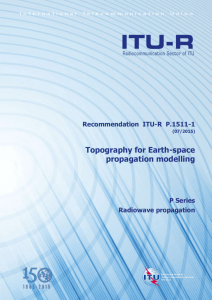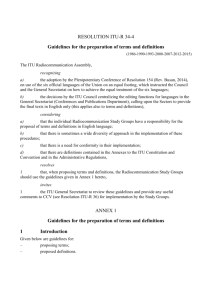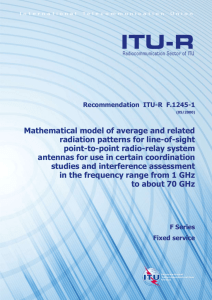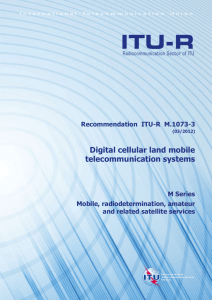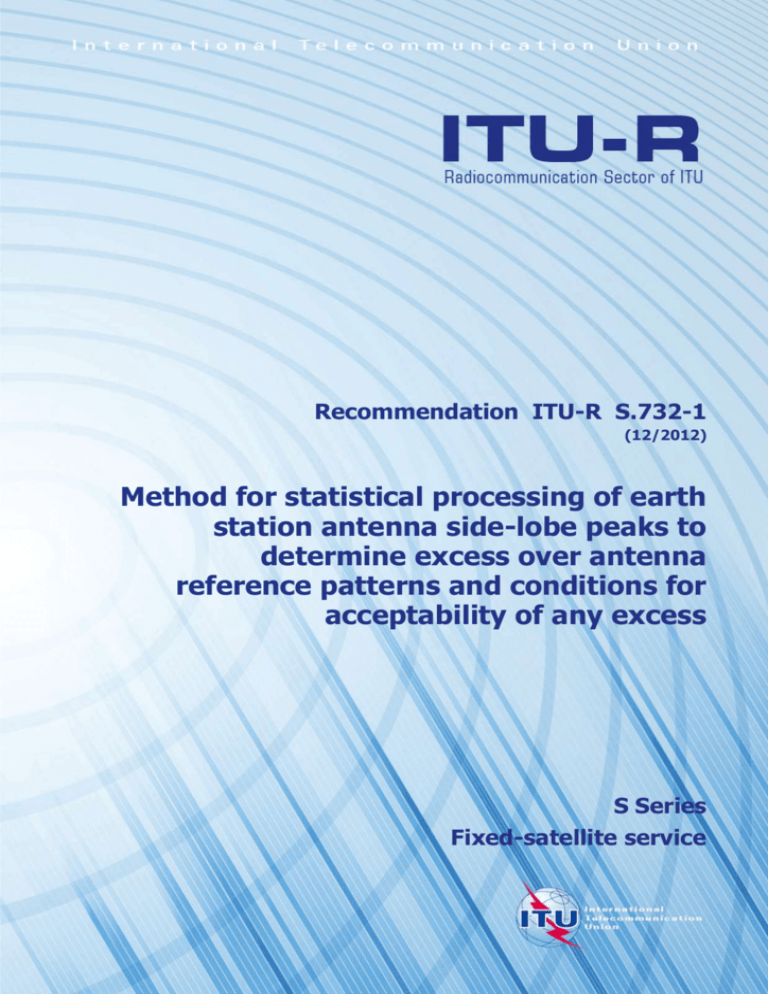
Recommendation ITU-R S.732-1
(12/2012)
Method for statistical processing of earth
station antenna side-lobe peaks to
determine excess over antenna
reference patterns and conditions for
acceptability of any excess
S Series
Fixed-satellite service
ii
Rec. ITU-R S.732-1
Foreword
The role of the Radiocommunication Sector is to ensure the rational, equitable, efficient and economical use of the
radio-frequency spectrum by all radiocommunication services, including satellite services, and carry out studies without
limit of frequency range on the basis of which Recommendations are adopted.
The regulatory and policy functions of the Radiocommunication Sector are performed by World and Regional
Radiocommunication Conferences and Radiocommunication Assemblies supported by Study Groups.
Policy on Intellectual Property Right (IPR)
ITU-R policy on IPR is described in the Common Patent Policy for ITU-T/ITU-R/ISO/IEC referenced in Annex 1 of
Resolution ITU-R 1. Forms to be used for the submission of patent statements and licensing declarations by patent
holders are available from http://www.itu.int/ITU-R/go/patents/en where the Guidelines for Implementation of the
Common Patent Policy for ITU-T/ITU-R/ISO/IEC and the ITU-R patent information database can also be found.
Series of ITU-R Recommendations
(Also available online at http://www.itu.int/publ/R-REC/en)
Series
BO
BR
BS
BT
F
M
P
RA
RS
S
SA
SF
SM
SNG
TF
V
Title
Satellite delivery
Recording for production, archival and play-out; film for television
Broadcasting service (sound)
Broadcasting service (television)
Fixed service
Mobile, radiodetermination, amateur and related satellite services
Radiowave propagation
Radio astronomy
Remote sensing systems
Fixed-satellite service
Space applications and meteorology
Frequency sharing and coordination between fixed-satellite and fixed service systems
Spectrum management
Satellite news gathering
Time signals and frequency standards emissions
Vocabulary and related subjects
Note: This ITU-R Recommendation was approved in English under the procedure detailed in Resolution ITU-R 1.
Electronic Publication
Geneva, 2013
ITU 2013
All rights reserved. No part of this publication may be reproduced, by any means whatsoever, without written permission of ITU.
Rec. ITU-R S.732-1
1
RECOMMENDATION ITU-R S.732-1
Method for statistical processing of earth station antenna side-lobe
peaks to determine excess over antenna reference patterns
and conditions for acceptability of any excess
(1992-2012)
Scope
This Recommendation sets forth a method for the statistical processing of earth station antenna side-lobe
peaks in order to determine the percentage of side-lobe peaks that exceed antenna reference patterns
provided in relevant ITU-R Recommendations. It also recommends conditions under which earth station
antenna side-lobe patterns with peaks exceeding recommended envelopes will still be considered as
compliant with ITU-R Recommendations that allow a certain percentage of side-lobe peaks to exceed the
recommended envelopes.
The ITU Radiocommunication Assembly,
considering
a)
that in determining the coordination distance or for assessing the interference between earth
stations and radio-relay stations, and for coordination studies between earth stations and space
stations of different satellite systems sharing the same frequency bands, it is necessary that the gain
of the earth station antenna be known in the relevant direction;
b)
that in the case of interference calculations between satellite systems, it may be desirable to
know the radiation characteristics of the antenna in planes other than the principal plane;
c)
that in calculating mutual interference between radio-relay systems and satellite
communication systems, particularly when there is more than one interference source, it is
preferable that the statistical properties of antenna side-lobe levels, as well as side-lobe peaks,
be known;
d)
that while ITU-R Recommendations on antenna radiation patterns may contain provisions
allowing side-lobe peaks to exceed the recommended envelope, these provisions have no
connection with the calculation of potential mutual interference in the course of coordination;
e)
that, in compiling statistical data, it is necessary to protect the integrity of such data from
experimental errors,
recognizing
a)
that Recommendation ITU-R S.580, which addresses earth station antenna design
objectives, allows a certain percentage of side-lobe peaks to exceed the reference pattern;
b)
that Recommendations containing reference antenna patterns used for interference analysis
and coordination between geostationary-satellite networks allow side-lobe peaks to exceed the
reference pattern only under specified circumstances (e.g. in the spillover regions, as
Recommendation ITU-R S.731, and local ground reflections at large off-axis angles, as
Recommendations ITU-R S.465 and ITU-R S.1855),
2
Rec. ITU-R S.732-1
recommends
1
that the following method should be used for processing measured data on side-lobes of
earth station antennas in the case where ITU-R recommended reference antenna radiation patterns
allow a certain percentage of side-lobe peaks to exceed the pattern:
1.1
that a side-lobe peak be defined as a local gain maximum for which an increase or
a decrease in off-axis angle shows a reduction in gain level of at least 2 dB (see Note 1);
1.2
the angular regions (sample windows) within which side-lobe peak samples are taken
should be defined as those shown in Table 2;
NOTE 1 – These "peaks" can be either above or below the allowed reference antenna pattern.
2
that measurement samples affected by experimental errors should be disregarded;
3
that the minimum angular resolution of antenna side-lobes measurement in Table 1 should
be used so that all side-lobes are captured:
TABLE 1
Minimum measurement resolution
Antenna size
Measurement resolution for
off-axis angle φ, φmin ≤ φ ≤ 30°
Measurement resolution for
off-axis angle φ, 30° < φ ≤ 180°
D/ < 25
0.5°
0.5°
25 D/ < 50
0.25°
0.5°
50 D/ < 250
0.1°
0.2°
250 ≤ D/
0.05° (or 0.1°) (see Note 2)
0.1°
NOTE 2 – In the case of large antennas having D/ > 250, when the largest dimension of the physical
aperture is greater than 12 m, the required angular measurement resolution is 0.1° for all off-axis angles.
Further studies may be necessary to determine the maximum size of the physical antenna aperture above
which 0.05° resolution measurements are not practical.
4
that the peak gain value of the side-lobes within each sample windows should not exceed
the reference patterns by more than Y dB, with Y given in Table 2:
TABLE 2
Angular regions (sample windows) for processing measured
side-lobe peak samples and allowed excesses
Angular regions/sample windows
Angular limits (°)
Allowed excess (Y in dB)
W1
φmin < φ ≤ 7
1
W2
7 < φ ≤ 9.2
3
W3
9.2 < φ ≤ 48
3
W4
48 < φ ≤ 180
10
In Table 2, the lower limit of the first angular region ΔφW1 is 1° or (100 λ/D) degrees, whichever is
greater;
Rec. ITU-R S.732-1
3
5
that when the number of side-lobe peaks is less than 10 in the specified angular regions, the
percentage of side-lobe peaks of the earth station antenna that do not comply with the reference
pattern should be determined using the following expression:
N
Xj 100 i W (%)
i 1
where:
j:
N:
i:
W:
index of the angular region W analysed, which varies from 1 to 4 according
to Table 2
number of side-lobe peaks exceeding the reference pattern within angular
region j
width of the ith side-lobe peak sample that exceeds the reference pattern
(degrees)
total sampled angular width of angular region j (degrees);
6
that antennas be deemed to be compliant with the reference antenna pattern if they meet the
condition stated in recommends 4 and the percentage of side-lobes exceeding the reference antenna
pattern does not exceed the allowed limit or, in the cases covered by recommends 5, no value of Xj
exceeds the allowed percentage of excess.


